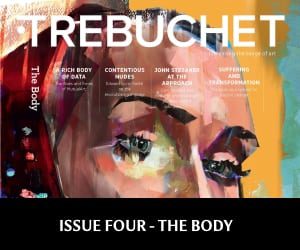During the 1980s, the iconic Stelarc started staging his famous suspension performances around the world, the artist suspended by hooks through his body. Visually arresting though the performances were, what strikes us now is how remarkably fresh the intention behind the work remains.
“Although the suspensions deal with the physical difficulty of the body strung up they have neither religious intent (transcending the body), the yearning for shamanistic empowering nor as yogic displays of control. They are realised with neither the intention of initiation rites nor the S&M exploration of pain and pleasure. What can be admitted though is that a painful experience does collapse the convenient distinction between the mind and body…
“The suspensions were a body sculpture installed in a space of other objects. The stretched skin is a kind of gravitational landscape. The penalty you pay for being suspended in a 1G gravitational field. Suspended and in stress the anonymous body realises its obsolescence…
“The nude and silent body at least in its static suspensions is an image of suspended animation. An anaesthetised and pacified body that is obsolete but not yet extinct. That has desires but does not express them. That feels pain but remains silent and stoic. A body that neither thinks nor expresses emotions.” – artist’s statement, 2018
Those performances received widespread coverage and Stelarc continued to explore the obsolescence and limits of the human body by incorporating robotics;. extra arms, ears and other sensors have all been part of this protean artist’s repertoire. Recognised by several institutions, Stelarc has received honorary professorships in Art and Robotics, as well as fellowship and research grants to continue his exploration into human hybrid interfaces. Given the broad possibilities for body extension, Trebuchet asked how Stelarc views the human body.
Stelarc: The biological body is an evolutionary architecture that operates and becomes aware in the world. Its survival parameters are very slim. Its longevity is relatively brief. It is soft and damages easily. It is vulnerable to microorganisms that are invisible but often fatal to it. Historically, it is an unstable construct, not only socially and culturally, but now its musculature is modified by machine augmentation and its cognitive capabilities amplified by computational systems. The more that this body performs, the more it realises it has no mind of its own—not any mind at all in the traditional metaphysical sense. The body has always been a zombie body that performs involuntarily and it has already become a cyborg body, performing in increasingly automated and remotely distributed ways.”
In what way do you feel you’ve pushed your conception and application of the body?
As a performance artist you have to take the physical consequences of your ideas. There is no interest in sci-fi speculation nor in futurist prediction. What is important is to engineer an interface, experience it in performance and thereby have something meaningful to say afterwards. Your ideas can only be authenticated by your actions. The body has always been seen as an object, not an object of desire but rather an object that should be redesigned: a body with a Third Hand (1980), an Extended Arm (2000) and an Extra Ear (2011).
As technology becomes microminiaturised it can become a component of the body, attached and even implanted. It is about the body in excess, the prosthesis not a sign of lack but a symptom of excess. The Third Hand was not only a visual attachment to the body but also gave it added capabilities. The Extended Arm had an 11-degree-of-freedom manipulator that extended my right arm to primate proportions. The Extra Ear: Ear on Arm is a soft prosthesis surgically constructed and cell-grown which will be electronically augmented and Internet-enabled for people to listen in from remote locations. It’s about exploring alternative anatomical architectures.
What potential do you see in bodies?
The body is profoundly obsolete…
Read this article in full in Trebuchet 4 – The Body

The aim of art is to represent not the outward appearance of things, but their inward significance. – Aristotle





















![L'Esprit comique [Der komische Geist], René Magritte, 1928. Courtesy Sammlung Ulla und Heiner Pietzsch, Berlin © 2025, ProLitteris, Zurich Photo Credit: Jochen Littkemann, Berlin](https://b276103.smushcdn.com/276103/wp-content/uploads/2025/07/ew11_0098489_2025-05-12_web-140x174.jpg?lossy=1&strip=0&webp=1)

